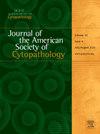Comparative analysis of Ficoll-Hypaque and CytoLyt techniques for blood removal in breast cancer malignant effusions: effects on RNA quality and sequencing outcomes
Q2 Medicine
Journal of the American Society of Cytopathology
Pub Date : 2025-03-01
DOI:10.1016/j.jasc.2024.11.001
引用次数: 0
Abstract
Introduction
To optimize RNA sequencing (RNA-seq) outcomes, we investigated preanalytical variables in malignant effusions containing metastatic breast cancer. We compared 2 processing methods—Ficoll-Hypaque density gradient enrichment and CytoLyt hemolysis—focusing on their effects on RNA quality, transcript abundance, and variant detection from cytospin slides, relative to fresh-frozen samples. Additionally, we compared read-based and Unique Molecular Identifier (UMI)-based library preparation methods.
Materials and methods
Thirteen malignant effusion specimens from metastatic breast cancer were processed using both the Ficoll-Hypaque and Cytolyt methods. RNA was extracted from fresh-frozen samples stored in RNA preservative and from cytospin slides fixed in Carnoy's solution. RNA quality was evaluated using RNA integrity number (RIN) and the percentage of fragments >200 bases (DV200). Sequencing was conducted with both read- and UMI-based methods.
Results
Purified RNA was more fragmented by the Cytolyt method (mean RIN: 3.56, DV200: 78.97%), compared to the Ficoll-Hypaque method (mean RIN: 6.29, DV200: 88.08%). Sequencing data had high concordance correlation coefficient (CCC) for measurements of gene expression, whether from Cytolyt or Ficoll-Hypaque treated samples, and whether using the UMI- or read-based sequencing methods (read-based mean CCC: 0.967 from Cytolyt versus 0.974 from Ficoll-Hypaque, UMI-based mean CCC: 0.972 from Cytolyt versus 0.977 from Ficoll-Hypaque).
Conclusions
Despite the increased RNA fragmentation with the Cytolyt, RNA-seq data quality was comparable across Cytolyt and Ficoll-Hypaque methods. Both clearing methods are viable for short-read RNA-seq analysis, with read and UMI-based approaches performing similarly.
Ficoll-Hypaque 和 CytoLyt 乳腺癌恶性渗出物血液清除技术的比较分析:对 RNA 质量和测序结果的影响。
简介:为了优化 RNA 测序(RNA-seq)结果,我们研究了含有转移性乳腺癌的恶性渗出物的分析前变量:为了优化 RNA 测序(RNA-seq)结果,我们研究了含有转移性乳腺癌的恶性渗出液的分析前变量。我们比较了两种处理方法--Ficoll-Hypaque密度梯度富集法和CytoLyt溶血法,重点研究了它们对RNA质量、转录本丰度和细胞切片变异检测的影响。此外,我们还比较了基于读取的文库制备方法和基于独特分子识别器(UMI)的文库制备方法:采用 Ficoll-Hypaque 和 Cytolyt 两种方法处理了 13 份转移性乳腺癌恶性渗出标本。从储存在 RNA 防腐剂中的新鲜冷冻样本和用卡诺伊溶液固定的细胞切片中提取 RNA。使用 RNA 完整性编号(RIN)和大于 200 碱基的片段百分比(DV200)评估 RNA 质量。测序采用基于读数和 UMI 的方法:结果:与 Ficoll-Hypaque 法(平均 RIN:6.29,DV200:88.08%)相比,Cytolyt 法(平均 RIN:3.56,DV200:78.97%)纯化的 RNA 片段更多。无论是 Cytolyt 还是 Ficoll-Hypaque 处理过的样本,也无论是使用 UMI 还是基于读数的测序方法,测序数据对基因表达的测量都具有很高的一致性相关系数(CCC)(Cytolyt 的基于读数的平均 CCC 为 0.967,Ficoll-Hypaque 的平均 CCC 为 0.967):Cytolyt 的平均 CCC 为 0.967,而 Ficoll-Hypaque 的平均 CCC 为 0.974;基于 UMI 的平均 CCC 为 0.972,而 Cytolyt 的平均 CCC 为 0.972:结论:结论:尽管使用 Cytolyt 会增加 RNA 片段的破碎,但 Cytolyt 和 Ficoll-Hypaque 方法的 RNA-seq 数据质量相当。这两种清除方法都适用于短读数 RNA-seq 分析,基于读数和 UMI 的方法性能相似。
本文章由计算机程序翻译,如有差异,请以英文原文为准。
求助全文
约1分钟内获得全文
求助全文
来源期刊

Journal of the American Society of Cytopathology
Medicine-Pathology and Forensic Medicine
CiteScore
4.30
自引率
0.00%
发文量
226
审稿时长
40 days
 求助内容:
求助内容: 应助结果提醒方式:
应助结果提醒方式:


